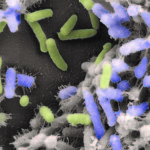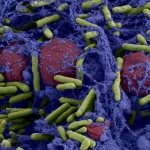Lien vers Pubmed [PMID] – 28407421
APMIS. 2017 Apr;125(4):365-375. doi: 10.1111/apm.12665.
The use of central venous catheters (CVC) is associated with a risk of microbial colonization and subsequent potentially severe infection. Microbial contamination of the catheter leads to the development of a microbial consortia associated with the CVC surface and embedded in an extracellular matrix, named biofilm. This biofilm provides bacterial cells the ability to survive antimicrobial agents and the host immune system and to disseminate to other sites of the body. The best preventive strategy is to avoid any unnecessary catheterization or to reduce indwelling duration when a CVC is required. Beside aseptic care and antibiotic-impregnated catheters (like minocycline/rifampin), preventive locks can be proposed in some cases, whereas non-biocidal approaches are under active research like anti-adhesive or competitive interactions strategies. When the diagnosis of catheter-related bloodstream infection (CRBSI) is suspected on clinical symptoms, it requires a microbiological confirmation by paired blood cultures in order to avoid unnecessary catheter removal. The treatment of CRBSI relies on catheter removal and systemic antimicrobials. However, antibiotic lock technique (ALT) can be used as an attempt to eradicate biofilm formed on the inside lumen of the catheter in case of uncomplicated long-term catheter-related BSI caused by coagulase-negative staphylococci (CoNS) or Enterobacteriaceae. Recently, promising strategies have been developed to improve biofilm eradication; they rely on matrix degradation or destabilization or the development of anti-persister compounds, targeting the most tolerant bacterial cells inside the biofilm. Understanding biofilm formation at the molecular level may help us to develop new approaches to prevent or treat these frequent infections.



